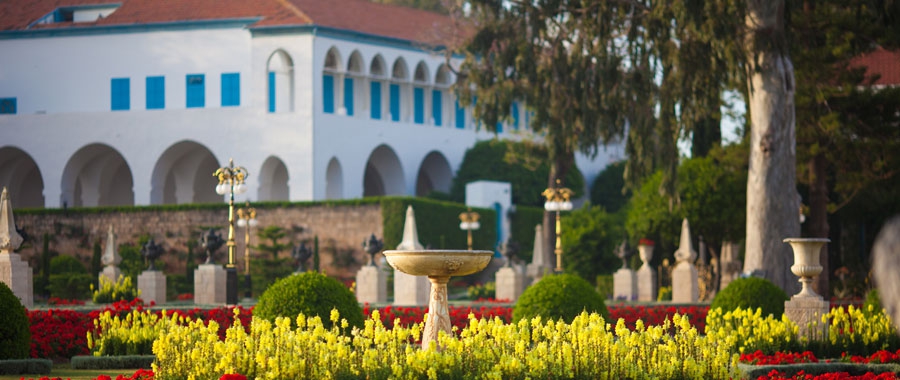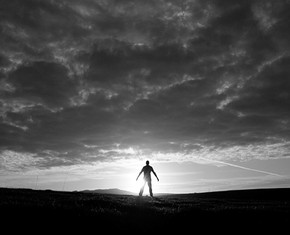The views expressed in our content reflect individual perspectives and do not represent the authoritative views of the Baha'i Faith.
In 1978, as a Baha’i pilgrim, I travelled to Israel for the first time, to visit the former prison city of Akka and nearby Bahji, the resting place of Baha’u’llah, the prophet and founder of the Baha’i Faith.
For Baha’is, Bahji is the holiest place on Earth, the place towards which Baha’is turn in prayer – the simple and dignified shrine which encloses Baha’u’llah’s tomb.
After I had bowed and humbly placed my forehead at the threshold of the room over Baha’u’llah’s tomb, I prayed for the enlightenment of my own soul and for the peace and unity of the nations of the world:
I bear witness to Thy unity and Thy oneness, and that Thou art God, and that there is none other God beside Thee. Thou hast, verily, revealed Thy Cause, fulfilled Thy Covenant, and opened wide the door of Thy grace to all that dwell in heaven and on earth. Blessing and peace, salutation and glory, rest upon Thy loved ones, whom the changes and chances of the world have not deterred from turning unto Thee, and who have given their all, in the hope of obtaining that which is with Thee. Thou art, in truth, the Ever-Forgiving, the All-Bountiful. – Baha’u’llah, Prayers and Meditations by Baha’u’llah, p. 315.
I beseech you, one and all, to add your prayers to mine to the end that war and bloodshed may cease, and that love, friendship, peace and unity may reign in the world.
All down the ages we see how blood has stained the surface of the earth; but now a ray of greater light has come, man’s intelligence is greater, spirituality is beginning to grow, and a time is surely coming when the religions of the world will be at peace. Let us leave the discordant arguments concerning outward forms, and let us join together to hasten forward the Divine Cause of unity, until all humanity knows itself to be one family, joined together in love. – Abdu’l-Baha, Paris Talks, p. 127.
Later that day, I crossed the Bay of Akka to the slopes of Mount Carmel, the mountain spoken of by Isaiah as the Mountain of the Lord. Part of every Baha’i pilgrimage involves a visit to the Shrine of the Bab, the resting place of the herald and prophet who announced the coming of Baha’u’llah. Set among the gardens, monuments and buildings of the Baha’i World Centre above Haifa on Mount Carmel is the International Baha’i Archives in which one of the photographs of Baha’u’llah is kept. Every Baha’i pilgrim has an opportunity to view it, and as I stood before it I finally knew what Baha’u’llah looked like. Just as Professor Browne struggled to describe him, I cannot describe the face I saw in that small photograph.
The picture shows Baha’u’llah seated in a chair with one arm resting on a table, wearing an abba, a cloak which flowed from his shoulders down to the ground. He was bearded, and his head was covered with a taj or turban, the kind worn by people from this part of the world in the latter half of the nineteenth century.
I knew the historical circumstances of the photograph. Baha’u’llah was being exiled yet again, and this was an official photograph of a prisoner. There was seriousness and profound resolve in his tired yet noble and radiant face. This was the countenance of the messenger of God, the Lord of the Age, Who had borne the torture, imprisonment and banishment of his enemies from the time of the birth of his religion.
Looking at the photograph, I suddenly realized that it really did not matter whether or not I knew what Baha’u’llah looked like.
The love I felt for him transcended any mental image, real or imaginary. It was his teachings which were important. As I stood there with the other pilgrims, I remembered what I had read of the life of the man in the photograph, a story which began many years before his exiles and imprisonment.
The actual birth of the Baha’i Faith began in the city of Shiraz, Persia, on the night of the 22nd of May 1844. The middle of the nineteenth century was a time of great messianic expectation in the world.
Throughout Europe and America millennialist Christian groups like the German Templers and American Millerites believed they had found in the Christian scriptures evidence supporting their conviction that history had ended and the return of Jesus Christ was at hand. In the Middle East, a markedly similar fervor developed around the belief that the fulfilment of various prophecies in the Qur’an and Islamic traditions was imminent. Against this backdrop of expectations a young descendant of the prophet Muhammad by the name of Siyyid Ali Muhammad declared Himself to be a messenger of God.
He assumed the title of Bab, which means “gate.” Like John the Baptist, the Bab claimed to be the forerunner and herald of one greater than himself. In preparation for the one whom he called “Him Whom God shall make manifest,” the Bab initiated new religious practices which replaced the old, outdated ones. He revealed prayers and laws providing his followers with insights into the spiritual and social requirements of a new age.
The story of the Bab is fascinating in its own right but too long to tell here. After eighteen people had spontaneously recognized the validity of the Bab’s claim through dreams and visions, and had become his disciples, the Bab wrote a letter and instructed the first of his followers to deliver it to Baha’u’llah. The letter informed Him of the new Revelation. Upon receiving this missive from the Bab, Baha’u’llah immediately championed his Cause.
The years following the Bab’s declaration were filled with turmoil. In a single year ferociously fanatical and ignorant Persian Muslims murdered four thousand adherents to his Cause. But after only six years, the Bab’s mission was complete. At the time of the dramatic, miracle-enshrouded martyrdom of the Bab in the northern city of Tabriz in 1850, His followers were unaware that Baha’u’llah had been chosen to be “Him Whom God shall make manifest,” the messenger of God foretold by the Bab.
This series of essays is adapted from Joseph Roy Sheppherd’s book The Elements of the Baha’i Faith, with permission from his widow Jan Sheppherd.
















Comments
Sign in or create an account
Continue with Googleor